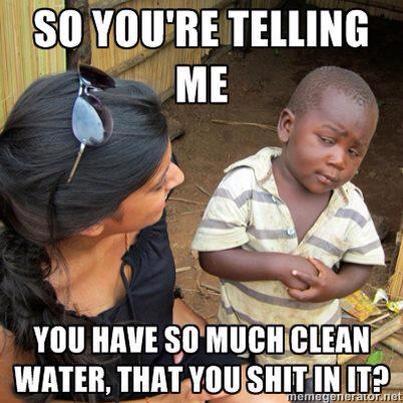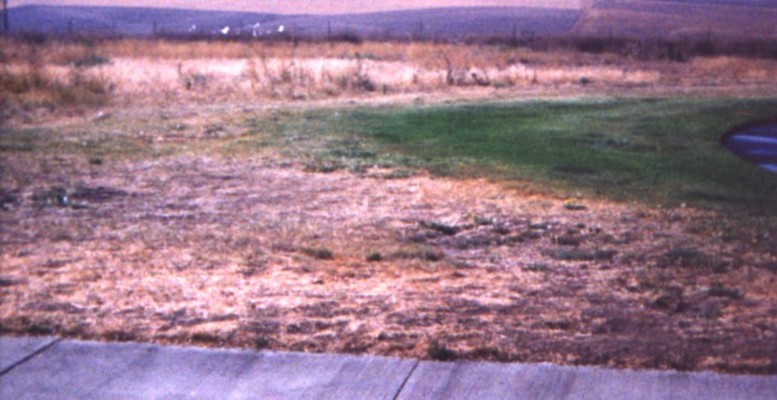|
|
|


Water Water everywhere but not enough to drink.
I have noticed in many areas an extreme lack of water as I have traveled the country over the years. While that is quite disturbing, what is more disturbing is the water I have seen. At rest areas in several states I have seen notices not to drink the water, bacteria, nitrates, nitrites, pesticides, herbicides, and other unspecified contaminates. Bottled water machines, at a buck or more a pop are at rest areas everywhere. The important thing to note however is that the biggest water problems are not in high population areas, but in the middle of cattle country. Elsewhere, I was greeted by closed beaches, high bacteria count, green tides or just minor irritations, just a little swimmers itch. Is this the legacy we want to leave for our grandchildren? Water is the basis for all life on this planet, these problems can not be ignored. For forty years the government has been studying the pollution in rivers and lakes, the message however is clear we must protect what little clean water there is left.
There are three major problems concerning water, one is too much AKA flooding. Scientists tell us that rapidly melting ice caps are a great concern why not bottle or store as much of this pristine water as we can bottles, tanks, pools, ponds, small lakes? Any storage of water will take it out of the cycle, less water less rain, less snow, less flooding...
then there is opposite problem dry wells, drought, dry farmlands it seems to me that if we can pipe and haul gas and oil all over the world, why not water?Then there is that third problem, water pollution, water has become the toxic asset of the new millennium. Many Creeks rivers lake and ponds have become too polluted to sustain life anymore, and not just in the third world. We must do everything possible to protect public waterways from all kinds of pollution and do what ever is necessary to clean up those that have become toxic assets for our grandchildren.
Congress took a more direct approach to NPS pollution with the Water by passing the Water Pollution Control Acts of 1972 and 1990, better known as the Clean Water Acts, it's obvious that some things have been slowed and some cleaned up, that pollution of our waterways is still a real problem. Passing laws don't do everything, we need a change in the core being of our consciousness as a society, Where people wouldn't even think about dumping oil antifreeze or anything else on the ground.
WASHINGTON 1/8/98-- In the first comprehensive analysis ever conducted of contaminated sediments in the nation's rivers, lakes and coastal waters, the Environmental Protection Agency has identified widespread risks to human health and the environment, especially in the New York region.
The report, which for the first time explicitly sets priorities for addressing the problem where the risks appear to be worst, puts New York, New Jersey, Pennsylvania and Connecticut high on the list. The study could provide new impetus to regional and federal pollution control efforts.
High-risk areas were identified either because sediments were found to be polluted or because factories and sewage treatment plants are known to be adding pollutants to the water. Among the high-risk areas identified were Long Island, Staten Island and Sandy Hook, N.Y., the Hackensack and Passaic watersheds in New Jersey, and the lower Hudson River from Newburgh to the New York City's harbor.
In the Hudson, as in many other local waterways, pollution of the sediment is a well-documented blight. While data about pollutants have been collected for years in various parts of the country, the new study for the first time assembled the information, using uniform toxicological methods to show where the health hazards are most concentrated. Its regional comparisons will for the first time enable researchers to focus their attention where it is most needed.
"I can guarantee you that our staff and our subcommittee is going to go over this very, very carefully," said Rep. Sherwood Boehlert, R-N.Y. Boehlert heads the House Subcommittee on Water Resources and Environment, which is scheduled this year to revise and extend the nation's water-related public works programs. The EPA's review, ordered by Congress five years ago, illuminates in rich new detail the poisons that linger in the muck, a hidden legacy of decades of industrial and agricultural pollution.
The people most at risk from highly contaminated sediments are people who frequently eat fish they catch themselves in local waters; often the fishermen are the poor or members of minorities. In many places, officials have already issued advisories against eating too much local fish.
The most common such contaminants are polychlorinated biphenyls, or PCBs, an especially persistent and toxic class of industrial chemicals whose use and disposal is now tightly controlled. But even if PCBs were excluded from the count, thousands of sites would still show risky levels of other chemicals, like mercury, metals, and pesticide residues, the report said.
"Contaminated sediment is one of the largest problems in this country," said Dr. Robert Huggett of Michigan State University, a chemical oceanographer who has worked in the field for three decades. A former EPA assistant administrator for research and development, he served on the panel of scientists that reviewed the new report.
"Many of the pollutants that enter our environment end up in our waterways," Huggett said, "and many of the ones that we are very concerned about, because they concentrate in human or animal tissues, don't stay in solution, but go into organisms or sediment. And the sediment ends up being a reservoir to recontaminate the environment."
Aside from New York's harbor, others around the country, including the Puget Sound, Boston Harbor, Detroit and Los Angeles, also "appear to have some of the most severely contaminated sediments in the country," the report said. That is not surprising, it said, because of the heavy boat traffic, the contaminants that flow downstream and settle in estuaries, and the many local sources of pollution in port cities.
But the evaluation found high risks in waters in every state in the country, and in settings as different as Kentucky Lake and the Willamette River in Oregon.
Whether the damage can be undone, or what should be done to avoid worsening it in the future, the report does not say. But in one of its three volumes, it identifies for the first time some of the most likely sources of continuing contamination.
"Obviously, the next step in our strategy is to target those trouble spots," Perciasepe said. The report identified 96 watersheds where the data showed the highest risks from contamination, mostly in the northeastern quarter of the country. Among the possible actions in some watersheds, he said, are new rules on dredging and disposing of contaminated sediments, an approach that has already been adopted in the New York harbor; further research into the severity of the hazards; programs to actually clean up some of the sites, especially where the responsible polluters are known; and tighter controls to avoid worsening the situation.
The agency said that harmful effects from pollution were likely at about a quarter of all the 21,000 monitoring stations where environmental officials have sampled sediments. At 50 percent of the sites, some harm was possible, and at the rest, there was no evidence of harm.
But the agency cautioned that those numbers exaggerate the severity of the problem because monitoring stations are most likely to be established in places where there is good reason to suspect contamination. A better estimate would be that 6 percent to 12 percent of the nation's underwater sediments contained damaging levels of pollution, the report said.
The three-volume report, the agency said, should be viewed as a "screening-level analysis," comparable to taking a person's blood pressure as a way to identify his risk for heart attacks.
In the 96 high-risk watersheds, about 7 percent of the total examined, the screening led to warnings that a closer look was justified and that remedial actions might be necessary.
Paradise Lost